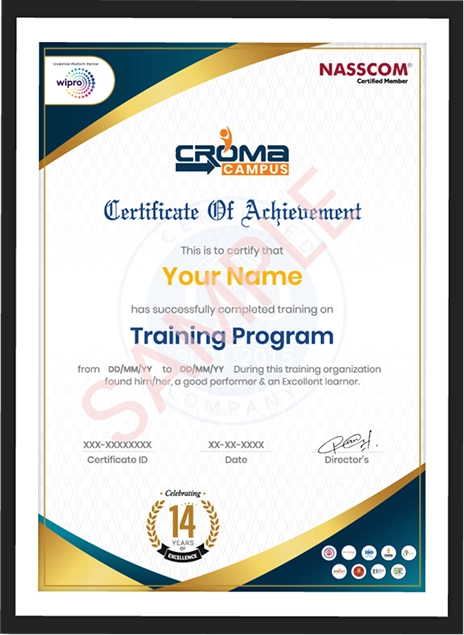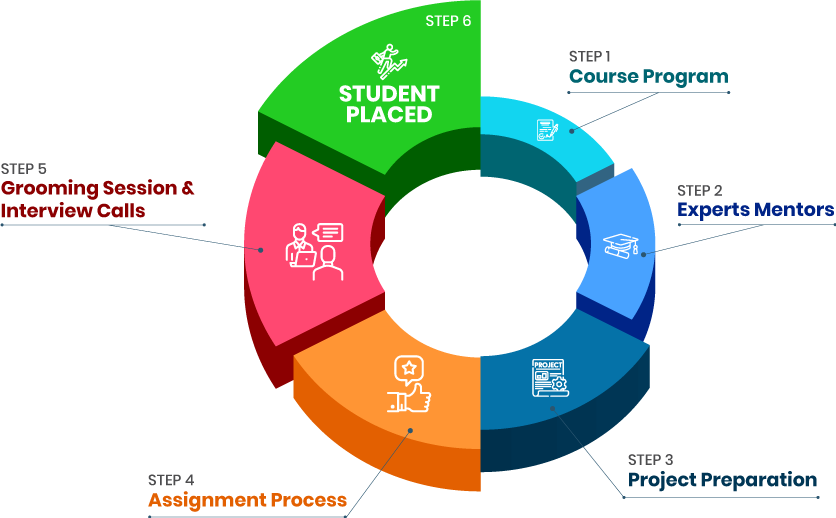- 2 Live Project
- Self-Paced/ Classroom
- Certification Pass Guaranteed
Course Offered By
Arithmetic
Relational
Logical
Assignment
Membership
Identity
History of JavaScript
What is ES6 (ECMAScript 6/JavaScript 6)
ES6 Module System
A Word on Bable
Block Scope, Let & Const
Template Literals
Arrow Functions
Spread and Rest Operators
Object Literal Improvements
De-structuring
Classes
Inheritance
Static Properties and Methods
Promises
Iterators and Iterables
Generators
Modules
New Features in ES6
JavaScript let
JavaScript let
JavaScript const
JavaScript Arrow Functions
JavaScript Classes
Default parameter values
Array.find()
Array.findIndex()
Exponentiation (**) (ECMA Script 2016)
History of Angular
The leap from AngularJS to Angular
Whats new in Angular 10
Angular 10 vs Angular 9
Desktop Application class User Experience
Productivity and Tooling
Performance
Community
Full-featured Framework
Supported Browsers (Angular 10)
Platform for Targeting Native Mobile not just Web Browsers
Introduction
What is Typescript
Why Typescript
Setup and installation
IDE support
Different typescript versions
Typescripts 3.8 for Angular 10
Scoping using let and const Keywords (ES6)
Template Literals (ES6)
Rest and Spread Parameters (ES6)
De-structuring (ES6)
Introduction to Types
Type inference
Type Annotations
Number
Boolean
String
Array
Tuple
ENUM
Any
Void
Spread and Rest Operators
Object Literal Improvements
De-structuring
Classes
Inheritance
Static Properties and Methods
Promises
Iterators and Iterables
Generators
Modules
New Features in ES6
JavaScript let
JavaScript const
JavaScript Arrow Functions
JavaScript Classes
Default parameter values
Array.find()
Array.findIndex()
Exponentiation (**) (ECMA Script 2016)
Audience
Pre-requisites
About Node
Execute Node
Features
Who use Node
Concepts
Where to use
Where not to use
Text Editor
NodeJs Run Time
Download NodeJs
Installation
Executing
Creating a NodeJs Application
Make a request to NodeJs Server
What is REPL
Starting REPL
REPL Commands
Stopping REPL
Installing Modules using NPM
Global vs Local Installation
Using packages.json
Attributes of packages.json
Uninstalling Module
Updating Module
Searching Module
Create a Module
Using Props
Default Props
State and Props
Validating Props
Set State
Force Update
Find DOM Node
Lifecycle Methods
Simple
Complex
Simple
Child
What is Refs
Using Refs
What is Keys
Using Keys
Install a React Router
Add a Router
Create Components
What is Flux
Flux Elements
Flux Props
Install REDUX
Create Files and Folders
Actions
Reducers
Store
Root Component
Other Components
Install React CSS Transitions Group
Add a CSS File
Appear Animation
Enter and Leave Animations
Connecting Node and MongoDB
Database Creation, Drop
Collection Operations
Documents Operations
Node and MongoDB Application
Introduction, Advantages
Environment Setup
Basic Application
Request
Response
GET
POST
Routing
HTTP Methods
URL Building
Middleware
Templates
Static Files
Form Data
Database
Cookies
Sessions
File Upload
Authentication
REST FUL APIs
Scaffolding
Debugging
Introduction, Advantages
History, Features
No SQL Databases
Advantages over RDBMS
Install MongoDB
MongoDB Shell
MongoDB Data Model
MongoDB Datatypes
Create Database
Drop Database
Create Collection
Drop Collection
Insert Documents
Update Documents
Delete Documents
Query Documents
Limit ()
Sort ()
Skip ()
History of JavaScript
What is ES6 (ECMAScript 6/JavaScript 6)
ES6 Module System
A Word on Bable
Block Scope, Let & Const
Template Literals
Arrow Functions
Spread and Rest Operators
Object Literal Improvements
De-structuring
Classes
Inheritance
Static Properties and Methods
Promises
Iterators and Iterables
Generators
Modules
New Features in ES6
JavaScript let
JavaScript const
JavaScript Arrow Functions
JavaScript Classes
Default parameter values
Array.find()
Array.findIndex()
Exponentiation (**) (ECMA Script 2016)
Audience
Pre-requisites
About React
Features
Advantages
Limitations
Create of Root Folder
Install Global Packages
Add Dependencies and Plugins
Create the Files
Set Compiler, Server and Loaders
html
JSX and Main.js
Running the Server
What is JSX
Using JSX
Nested Elements
Attributes
JavaScript Expressions
Styling
Components
Naming Convention
Stateless
State full
What is State
Props
Using Props
Default Props
State and Props
Validating Props
Set State
Force Update
Find DOM Node
Lifecycle Methods
Simple
Complex
Simple
Child
What is Refs
Using Refs
What are Keys
Using Keys
Install a React Router
Add a Router
Create Components
What is Flux
Flux Elements
Flux Props
Audience
Pre-requisites
About Node
Execute Node
Features
Who use Node
Concepts
Where to use
Where not to use
Text Editor
NodeJs Run Time
Download NodeJs
Installation
Executing
Creating a NodeJs Application
Make a request to NodeJs Server
What is REPL
Starting REPL
REPL Commands
Stopping REPL
Installing Modules using NPM
Global vs Local Installation
Using packages.json
Attributes of packages.json
Uninstalling Module
Updating Module
Searching Module
Create a Module
Using Props
Default Props
State and Props
Validating Props
Set State
Force Update
Find DOM Node
Lifecycle Methods
Simple
Complex
Simple
Child
What is Refs
Using Refs
What is Keys
Using Keys
Install a React Router
Add a Router
Create Components
What is Flux
Flux Elements
Flux Props
Install REDUX
Create Files and Folders
Actions
Reducers
Store
Root Component
Other Components
Install React CSS Transitions Group
Add a CSS File
Appear Animation
Enter and Leave Animations
Connecting Node and MongoDB
Database Creation, Drop
Collection Operations
Documents Operations
Node and MongoDB Application
Introduction, Advantages
Environment Setup
Basic Application
Request
Response
GET
POST
Routing
HTTP Methods
URL Building
Middleware
Using Props
Default Props
State and Props
Validating Props
Set State
Force Update
Find DOM Node
Lifecycle Methods
Simple
Complex
Simple
Child
What is Refs
Using Refs
What is Keys
Using Keys
Install a React Router
Add a Router
Create Components
What is Flux
Flux Elements
Flux Props
Introduction, Advantages
History, Features
No SQL Databases
Advantages over RDBMS
Install MongoDB
MongoDB Shell
MongoDB Data Model
MongoDB Datatypes
Create Database
Drop Database
Create Collection
Drop Collection
Insert Documents
Update Documents
Delete Documents
Query Documents
Limit ()
Sort ()
Skip ()
What is a Web Browser
What are Versions of HTML
What can you Do with HTML
HTML Development Environments
Writing Code with a Text Editor
Rules of Syntax
Making your Code Readable
Building a Document
Using Colors
Adding Color to your Page
Using Headings
Using Paragraphs
Aligning Block-Level Elements
Displaying Preformatted Text
Formatting with Inline Elements
Controlling Fonts
Introducing List Elements
Creating Unordered Lists
Creating Ordered Lists
Nesting Lists
Building a Table
Cell Padding and Cell Spacing
Controlling Table and Cell Width
Aligning a Table on the Page
Aligning Tables and Text
Aligning Table Data
Spanning Columns and Rows
Understanding and Using URLs
Linking to a Web Document
Linking to a Local Document
Linking to Anchors
Opening a New Browser Window
Inserting Inline Images
Aligning Images
Using Images to Anchor Links
Sizing Images
Using Transparent Images
Using GIF Animation
Forms and Form Elements
Form Actions, Form Methods, Form Design
Laying out a page with HTML5
Page Structure
New HTML5 Structural Tags
Page Simplification
New Features of HTML5
The HTML5 Semantic Element
Current State of Browser Support
The section Tag
The article Tag
The header Tag
The Footer Tag
Supported Media Types
The audio Element
The video Element
New Input Types
autocomplete
novalidate
required
placeholder
autofocus
autocomplete
form
pattern
Inline
Internal
External
ID
Class
Attribute
Grouping
Universal
RGB Value
Hex Value
Color Name
background-color
background-repeat
background-attachement
background position
background-size
background-image
Margin-top
Margin-bottom
Margin-left
Margin-Right
Padding -top
Padding -bottom
Padding -left
Padding –Right
Outline-style
Outline-color
Outline Width
Outline-Offset
Outline Shorthand Property
Border
border-radius
Text-shadow
Box-shadow
transition
transition-delay
transition-duration
transition-property
transform
matrix ()
translate (x, y)
scale (x, y)
rotate(angle)
skew (x-angle, y-angle)
@keyframes
animation
animation-direction
animation-duration
animation-name
CSS combinations
Pseudo Elements
Linear Gradients
Radial Gradients
resize
box-sizing
outline-offset
Blur
Opacity
What is Responsive Web Design
Intro to the Viewport
The Viewport Tag
Media Queries
Tablet Styles
Mobile Styles
Making a Mobile Drop-down Menu
@font-face
font-family
src
font-stretch
font-style
font-weight
flex-grow
flex-shrink
flex-basis
flex
flex-wrap
flex-direction
flex-flow
justify-content
align-items
order
Syntax
Statements
Comments
Alert
Confirm
Prompt
Arithmetic
Assignment
Comparison
Logical
Relational
Ternary
If else
if...else if...else
nested if
Switch
Loops
While
do...while
for
for...in Statement
Break
Continue
User-defined Functions
Function Syntax
Function with Arguments
Returning Values from Functions
Built-in Functions
Introduction
Mouse
Events
Keyboard Events
Form Events
Document/Window Events
Number
Strings
Math
Array
Date
Reg exp use in form validation
History of JavaScript
What is ES6 (ECMAScript 6/JavaScript 6)
ES6 Module System
A Word on Bable
Block Scope, Let & Const
Template Literals
Arrow Functions
Spread and Rest Operators
Object Literal Improvements
De-structuring
Classes
Inheritance
Static Properties and Methods
Promises
Iterators and Iterables
Generators
Modules
New Features in ES6
JavaScript let
JavaScript const
JavaScript Arrow Functions
JavaScript Classes
Default parameter values
Array.find()
Array.findIndex()
Exponentiation (**) (ECMA Script 2016)
Audience
Pre-requisites
About React
Features
Advantages
Limitations
Create of Root Folder
Install Global Packages
Add Dependencies and Plugins
Create the Files
Set Compiler, Server and Loaders
html
JSX and Main.js
Running the Server
What is JSX
Using JSX
Nested Elements
Attributes
JavaScript Expressions
Styling
Components
Naming Convention
Stateless
State full
What is State
Props
Using Props
Default Props
State and Props
Validating Props
Set State
Force Update
Find DOM Node
Lifecycle Methods
Simple
Complex
Simple
Child
What is Refs
Using Refs
What are Keys
Using Keys
Install a React Router
Add a Router
Create Components
What is Flux
Flux Elements
Flux Props
Audience
Pre-requisites
About Node
Execute Node
Features
Who use Node
Concepts
Where to use
Where not to use
Text Editor
NodeJs Run Time
Download NodeJs
Installation
Executing
Creating a NodeJs Application
Make a request to NodeJs Server
What is REPL
Starting REPL
REPL Commands
Stopping REPL
Installing Modules using NPM
Global vs Local Installation
Using packages.json
Attributes of packages.json
Uninstalling Module
Updating Module
Searching Module
Create a Module
Using Props
Default Props
State and Props
Validating Props
Set State
Force Update
Find DOM Node
Lifecycle Methods
Simple
Complex
Simple
Child
What is Refs
Using Refs
What is Keys
Using Keys
Install a React Router
Add a Router
Create Components
What is Flux
Flux Elements
Flux Props
Install REDUX
Create Files and Folders
Actions
Reducers
Store
Root Component
Other Components
Install React CSS Transitions Group
Add a CSS File
Appear Animation
Enter and Leave Animations
Connecting Node and MongoDB
Database Creation, Drop
Collection Operations
Documents Operations
Node and MongoDB Application
Introduction, Advantages
Environment Setup
Basic Application
Request
Response
GET
POST
Routing
HTTP Methods
URL Building
Middleware
Using Props
Default Props
State and Props
Validating Props
Set State
Force Update
Find DOM Node
Lifecycle Methods
Simple
Complex
Simple
Child
What is Refs
Using Refs
What is Keys
Using Keys
Install a React Router
Add a Router
Create Components
What is Flux
Flux Elements
Flux Props
Introduction, Advantages
History, Features
No SQL Databases
Advantages over RDBMS
Install MongoDB
MongoDB Shell
MongoDB Data Model
MongoDB Datatypes
Create Database
Drop Database
Create Collection
Drop Collection
Insert Documents
Update Documents
Delete Documents
Query Documents
ASP.NET and MVC
Advanced C#
WCF [Windows Communication Foundation]
WPF [Windows Presentation Foundation Using C#]
Controller Techniques
Defining Filters
Implementing Compression
Model Binding Techniques
Caching
Globalization and Localization
Html5 Semantic Tags
Html5 Accessibilty
Search Engine Optimization
Getting Started with Code Contracts
Using Code Contracts
Handling Errors
Implementing Logging and Monitoring
Di Concepts
Di Techniques in ASP.Net MVC 6
Design and Architecture Considerations
Recap of Tdd
Introduction to Xunit.Net
Walk-Through of Using Tdd With ASP.Net MVC 6
Understanding Web Sockets
Defining A Web Sockets Server
Defining A Web Sockets Client
Using Signal R
Overview of The Http Pipeline
Overview of Owin
Implementing Owin Middleware Components
Overview of Authentication
Implementing Windows Authentication
Implementing Forms Authentication
Implementing Auth Authentication
Implementing Claims-Based Authentication
Managing Data integrity
Implementing A Secure Site
Windows Azure Concepts
Windows Azure Architecture and Components
Creating a Cloud Service Application
Running a Cloud Service Application
Web Deploy Using Visual Studio
Web Deployment Packages
Command - Line Tools for web Deploy
Deploying to windows Azure
Practice TDD with Xunit.Net & Asp.Net MVC
nsAdvanced Controller and View Techniques
MVC Dependancy injection
Implementing Own Middleware Components
Creating Full-Duplex Web Sockets Solutions
MVC 6 Security
Devloping and Deploying Azure Solutio
Language shortcuts
Applying auto-implemented and lambda generated properties
Benefiting from dynamic and implied-type declaration
Streamlining program logic
Instantiating entity object
simplifying construction with object initializers
Filtering and ordering data with lambda expressions
Passing lambda expressions to methods (behavior vs. data)
Calling Count, Reverse, Union, Except and other extension methods
Applying extended features
Making code more flexible with delegates
Parameterizing delegates and lambda expressions
Streamlining code with Function
Syntax and semantics
Coding LINQ queries
Filtering with from where order by and group
Preforming inner and outor joins
Iterating collections able
Interfacing between C# and LINQ using Ienumerable
Issuing queries on entity and spatial types
Connecting to and reading from a database
Inheriting Core Db Context objects
Correlating entity classes and data tables
Executing stored procedures and table-valued functions
Object Relational Mapping
Employing code-first and database first mapping to generate entity classes
Optimizing complex mapping including many to many and database inheritance
Updating a database
Inserting, updating and deleting data when Core is integrated with .NET Framework
Error handling and exceptions
Committing and rolling back transactions
Introduction to Course Outline
Evolution of WCF
What is WCF
Overview of Different Types of Contracts in (WCF)
Introduction to SOA
Steps Involved in Developing, Hosting and Consuming a WCF Service
Creating a WCF Service Application
Creating a WinForms Client for our WCF Service
Overview of App. Config file
Creating a Simple WCF Service Library
Performing Web Hosting of our WCF Service
Developing a Winforms Client for our WCF Service
Developing a WCF Service Library and Self Host Application
Developing a Winforms Client for our WCF Service
Testing the Winforms Client
Developing Multiple WCF Libraries and a Single Self Host Application
Developing and Testing a Winforms Client for our multiple WCF Services
Developing a WCF Service Library
Working with App.config
working with Configuration Editor
Developing a Winforms Client for our WCF Service using a Configuration File
Developing a WCF Service Library
Developing a Windows Service to Host Our WCF Service
Developing a Winforms Client for our WCF Service
Developing a WCF Service Library
Developing a Self-Host Application using a Service Reference
Developing a Winforms Client for our WCF Service
Developing a WCF Service Library
Install Required Roles and Features using Server Manager
Develop a Web Host Service on IIS
Working with AppCmd to Enable NetTcp Binding
Developing a Winforms Client for our WCF Service
Developing a WCF Service Library
Implement Duplex Methods in a WCF Service and Test
Implement Duplex Methods in a WCF Service and Test - Part I
Implement Duplex Methods in a WCF Service and Test - Part II
Throwing .NET CLR Errors from a WCF Service Method
Throwing .NET CLR Errors from a WCF Service is OneWay Method
Throwing Fault Exceptions from a WCF Service
Throwing Strongly Typed Fault Exceptions
Developing a WCF Service Library
Working with PerSession InstanceContextMode
Working with PerCall InstanceContextMode
Working with Single InstanceContextModes
Developing a WCF Service Library with Transaction Support
Developing a Web Host Application
Developing a Winforms Client to Test out Transaction Support
Developing a WCF Service Library with Sessions Transaction Support
Developing a Winforms Client for WCF Service to test Sessions and Transactions
Developing a WCF Service Library with Session Concurrency Support
Developing a Host Application
Developing a Winforms Client to Test Session Concurrency Effect
What WPF
What Is WPF
.NET Framework 4.0 (WinFX)
WPF Overview
Application and Window
A Simple WPF Application
Using Visual Studio
Brushes
Panels
Role of XAML
Elements and Attributes
Namespaces
Property Elements
Type Conveters
Content Property
Collections
XAML and Procedural Code
Button | Label | Text Box
ToolTip | Radio Button | Checkbox
List Box | Combo Box
Sizing | Positioning | Transforms
Canvas | Drawing Shapes
Stack Panel | Wrap Panel | Dock Panel
Grid | Scrolling | Scaling
Dialogs
Message Boxes
Win32 Common Dialogs
Custom Modal Dialogs
Custom Modeless Dialogs
Menus | Context Menus
Icons on Menu Items
Commands
Keyboard Shortcuts
Disabling Menu Items | Checking Menu Items
Toolbars | Toolbars and Commands
Status Bars
Dependancy Properties
Change Notification
Property Value Inheritance
Support for Multiple Providers
Routed Events
Routing Strategies
Resources in WPF
Binary Resources
Logical Resources
Static versus Dynamic Resources
Style, Style Sharing
Triggers
Templates
Templated Parent’s Properties
Skins | Themes
Binding Sources
Sharing Sources with Data Context
Data Templates
Value Converters
Collection Views | Data Providers
Understand the WPF architecture and advantages
Become proticient with the use of XAML
Layout and containers in WPF
Achieve reuse and maintainability with resources, styles,and templates
Build compelling user experiences with custom drawing and animations
Learn how to properly apply the MVVM design pattern via applications of increasing complexity
Introduction to Windows 8 Applications
What is a Web Browser
What are Versions of HTML
What can you Do with HTML
HTML Development Environments
Writing Code with a Text Editor
Rules of Syntax
Making your Code Readable
Building a Document
Using Colors
Adding Color to your Page
Using Headings
Using Paragraphs
Aligning Block-Level Elements
Displaying Preformatted Text
Formatting with Inline Elements
Controlling Fonts
Introducing List Elements
Creating Unordered Lists
Creating Ordered Lists
Nesting Lists
Building a Table
Cell Padding and Cell Spacing
Controlling Table and Cell Width
Aligning a Table on the Page
Aligning Tables and Text
Aligning Table Data
Spanning Columns and Rows
Understanding and Using URLs
Linking to a Web Document
Linking to a Local Document
Linking to Anchors
Opening a New Browser Window
Inserting Inline Images
Aligning Images
Using Images to Anchor Links
Sizing Images
Using Transparent Images
Using GIF Animation
Forms and Form Elements
Form Actions, Form Methods, Form Design
Laying out a page with HTML5
Page Structure
New HTML5 Structural Tags
Page Simplification
New Features of HTML5
The HTML5 Semantic Element
Current State of Browser Support
The section Tag
The article Tag
The header Tag
The Footer Tag
Supported Media Types
The audio Element
The video Element
New Input Types
autocomplete
novalidate
required
placeholder
autofocus
autocomplete
form
pattern
Inline
Internal
External
ID
Class
Attribute
Grouping
Universal
RGB Value
Hex Value
Color Name
background-color
background-repeat
background-attachement
background position
background-size
background-image
Margin-top
Margin-bottom
Margin-left
Margin-Right
Padding -top
Padding -bottom
Padding -left
Padding –Right
Outline-style
Outline-color
Outline Width
Outline-Offset
Outline Shorthand Property
Border
border-radius
Text-shadow
Box-shadow
transition
transition-delay
transition-duration
transition-property
transform
matrix ()
translate (x, y)
scale (x, y)
rotate(angle)
skew (x-angle, y-angle)
@keyframes
animation
animation-direction
animation-duration
animation-name
CSS combinations
Pseudo Elements
Linear Gradients
Radial Gradients
resize
box-sizing
outline-offset
Blur
Opacity
What is Responsive Web Design
Intro to the Viewport
The Viewport Tag
Media Queries
Tablet Styles
Mobile Styles
Making a Mobile Drop-down Menu
@font-face
font-family
src
font-stretch
font-style
font-weight
flex-grow
flex-shrink
flex-basis
flex
flex-wrap
flex-direction
flex-flow
justify-content
align-items
order
Syntax
Statements
Comments
Alert
Confirm
Prompt
Arithmetic
Assignment
Comparison
Logical
Relational
Ternary
If else
if...else if...else
nested if
Switch
Loops
While
do...while
for
for...in Statement
Break
Continue
User-defined Functions
Function Syntax
Function with Arguments
Returning Values from Functions
Built-in Functions
Introduction
Mouse
Events
Keyboard Events
Form Events
Document/Window Events
Number
Strings
Math
Array
Date
Reg exp use in form validation
Software architecture and its flow to design a layout
Technologies needed For Full Stack
Current market requirements on UI/UX
Difference between UI/UX design
UI/UX Developer roles and Responsibilities
Figma design and prototypes
Basics
HTML5
Introduction
More Properties
Introduction, History and Syntax
How to use JS in different ways
Popup Boxes, alerts, prompt, confirm
Variable type
Data Types
Operators
Conditional Statements & Loops
Functions
Arrays & Strings
Events
Object and its property
This keyword
RegExp
ErrorHandling & async-await conepts
Introduction
Bootstrap5 and comparison with previous versions
How to download or start with CDN
Grid System and Flex Concept in bootstrap 5
Typography, Colors, Buttons
Images, tables, Alerts, Badges, spinner
Cards, Pagination, list groups
Dropdown and collapse concept
Responsive Forms (Contact Form)
Navbar and footer
Carousel and Modal
Tooltip, popover and Toast
Scroll spy and offcanvas
Utilities
Introduction and uses
Selectors and Events in jQuery
jQuery Effects
jQuery HTML
jQuery Traversing
jQuery AJAX
Introduction to ECMAScript 2015
Modern Java Script and React js
Var, Let and Const in JavaScript
Template literals (Template strings) in ES6
New Strings Methods in ES6
Array Destructuring & Object Destructuring in ES6
Fat Arrow Function
Default & REST Parameters in ES6
Spread Operator in ES6
New Array Methods in JavaScript
New Numbers & Global Methods
OOPS (Classes, Object & Inheritance) in ES6
Async Await in JavaScript
Error Handling in JavaScript
Fetch API in Promises in JavaScript
Introduction, prerequisites and uses
Package Manager (yarn, npm, pnpm, bun with vite)
Environment Setup, download and install with VS Code
Basic Syntex and Folder Structure
JSX and Java script Expression in JSX
React Components (Functional Components)
Render Multiple Elements (React fragment)
Module import and Export
Inserting images in react
CSS styling in React
JS Map Method & key concept in react
Conditional rendering in react
Arrays in React
Props Concepts in react
Event Propagation in react
Bootstrap in React
Hooks Concept
State Management (useState)
useEffect
useContext
useCallback
useParam
useNevigate
useRef
useReducer
Router and create a navbar in react
Use Bootstrap5 in React
Fetch API Data in React
Axios With Get & Post
Form in React with Login Form Submition
Component Lifecycle
Mounting and Unmouting in react
Animations in React
Traversal, insertion, deletion
Searching & sorting (binary search, merge sort, quick sort)
Two-pointer technique
Sliding window
String manipulation (palindrome, anagram, substring)
Pattern matching
StringBuilder vs StringBuffer
Regex basics
Singly & doubly linked list
Reversal, cycle detection (Floyd's algorithm)
Merge two sorted lists
Stack using array/linked list
Infix, postfix, prefix expressions
Queue, Circular Queue, Priority Queue
Deque
Basic recursion patterns
Backtracking
HashMap, HashSet
Frequency count, duplicates
Binary Tree, Binary Search Tree (BST)
Traversals (in-order, pre-order, post-order)
Java History and Versions
Differences between java and others
Java Features
Java Naming Conventions
Introduction to Java architecture: JDK, JRE, and JVM.
Java Installation and setup with VS code
Text-Editors
Run and Compile a Java Files
Explain the Java file Structure
Operators
Identifiers
Literals
Data Types and Type casting
Java Statements
Arrays
Variable and Identifiers
Data Types and Type casting
Tokens and Literals in Java
Operators
Arrays and Strings in Java
User input with Scanner Class
Control Flow Statement in java
Create and Call Methods
Parameters and Arguments
Recursion in Methods
Method Overloading & Scopes
Introduction
Class and Objects
Attributes and Methods with example
Constructors and its parameters
Modifiers
Encapsulations
Inheritance concept
Overloading Vs Overriding
Polymorphism in Java
Static, This and final Keyword in java
Abstract class and method in java
Interfaces in java
Enums in Java
Types of classes
Exceptional handling in Java
Regular expression (RegEx) in Java
I/O Streams in Java
Generics in java
What is a package
Types of packages
Class
Field
Method
Constructor
Introduction
Approaches to make an object for GC
Methods for requesting JVM to run GC
Finalization
Collection Architecure
List and its implementations
Hash Set
Hash Map
Queue and its implementations
Iterators
Collectors
Lambda Expressions
Stream APIs
Date and Time APIs
Java 8 features into collection framework
MultiThreading
Introduction to Web Development
Three layer architecture
Servlet Basics
Advanced Servlet Concepts
Introduction to JSP
Advanced JSP Concepts
Integrating JSP and Servlets
Introduction to JDBC
JDBC Basics
Advanced JDBC Concepts
Transaction Management
Connection Pooling
Error Handling in JDBC
Security in JDBC Applications
Deployment of JDBC
Introduction to Hibernate
Basic Hibernate Concepts
Mapping Relationships
Querying with Hibernate
Performance Optimization
Introduction to Spring Framework
Spring Core Concepts
Annotations and @Autowired in Spring
Spring AOP (Aspect-Oriented Programming)
Three-Layer Architecture in Spring
Spring Data Access
Spring MVC
Introduction to Spring Boot
Spring Boot Core Concepts
Building RESTful Web Services with Spring Boot
Spring Boot Data Access
Spring Boot Testing
Spring Security
Microservices with Spring Boot
Advanced Spring Boot Features
Capstone Projects
we train you to get hired.
Phone (For Voice Call):
+91-971 152 6942WhatsApp (For Call & Chat):
+91-971 152 6942Stories
success
inspiration
career upgrade
career upgrade
career upgrade
career upgrade
You will get certificate after
completion of program
You will get certificate after
completion of program
You will get certificate after
completion of program
in Collaboration with

Empowering Learning Through Real Experiences and Innovation
we train you to get hired.
Phone (For Voice Call):
+91-971 152 6942WhatsApp (For Call & Chat):
+91-971 152 6942Get a peek through the entire curriculum designed that ensures Placement Guidance
Course Design By
Course Offered By
Ready to streamline Your Process? Submit Your batch request today!
Highest Salary Offered
Average Salary Hike
Placed in MNC’s
Year’s in Training

fast-tracked into managerial careers.
Get inspired by their progress in the
Career Growth Report.
FOR QUERIES, FEEDBACK OR ASSISTANCE
Best of support with us
For Voice Call
+91-971 152 6942For Whatsapp Call & Chat
+91-9711526942




















